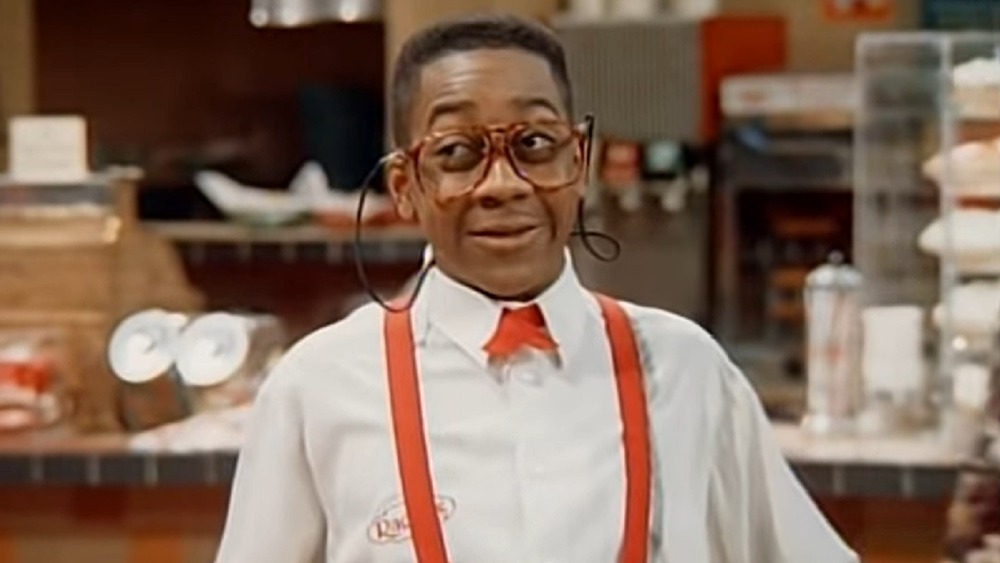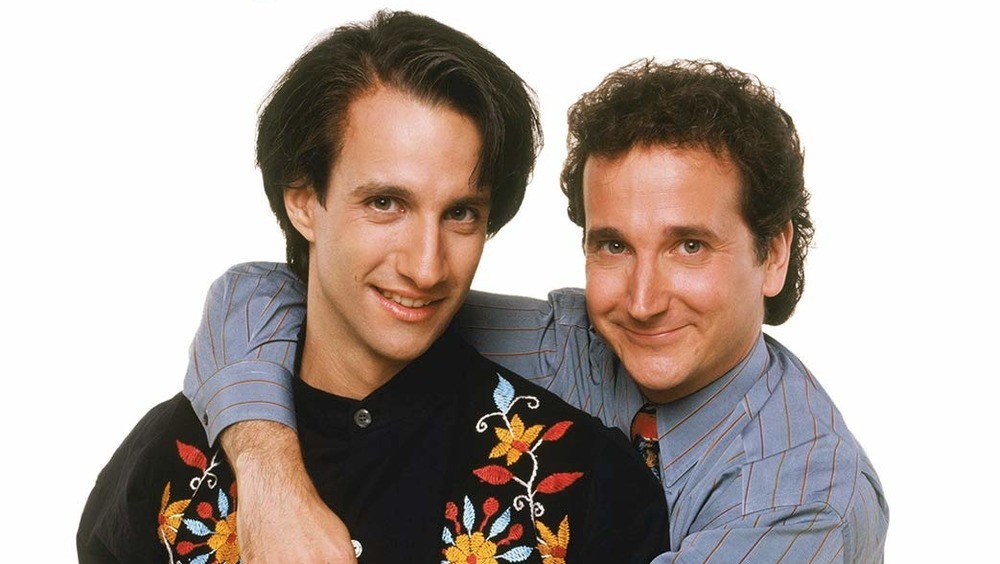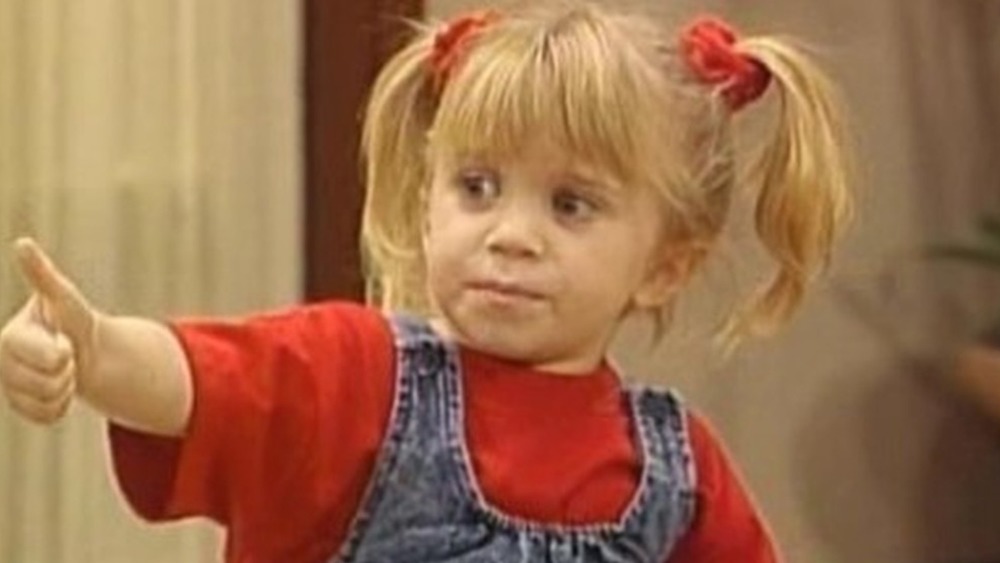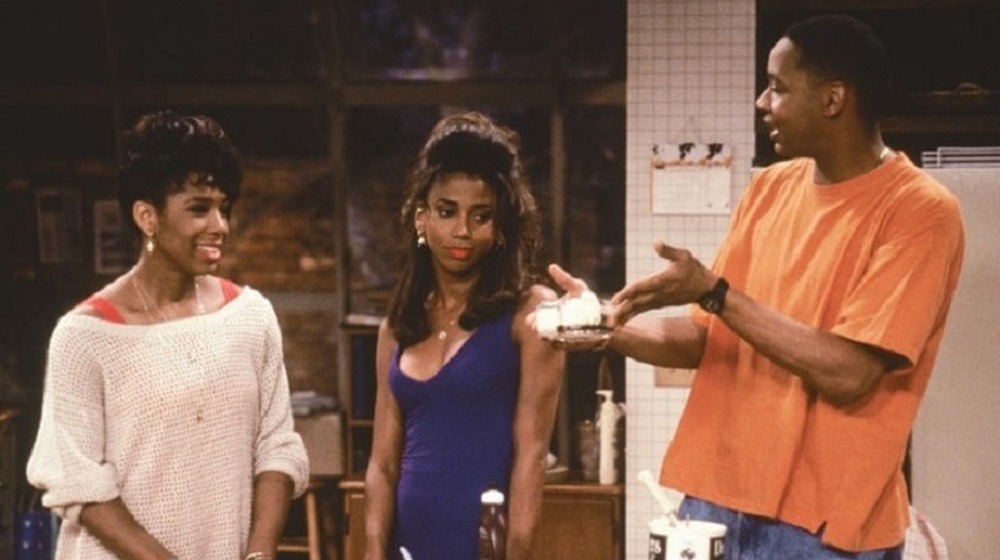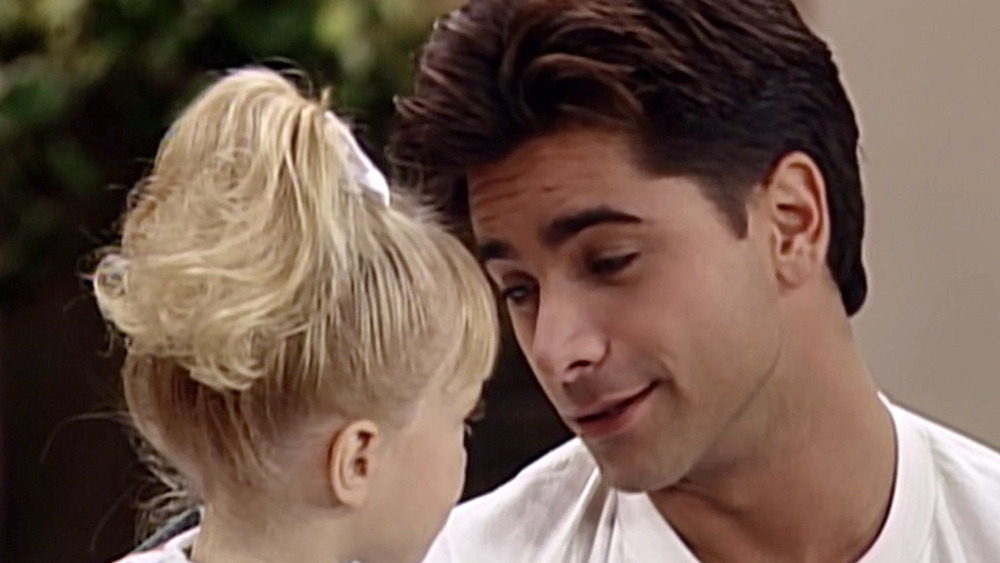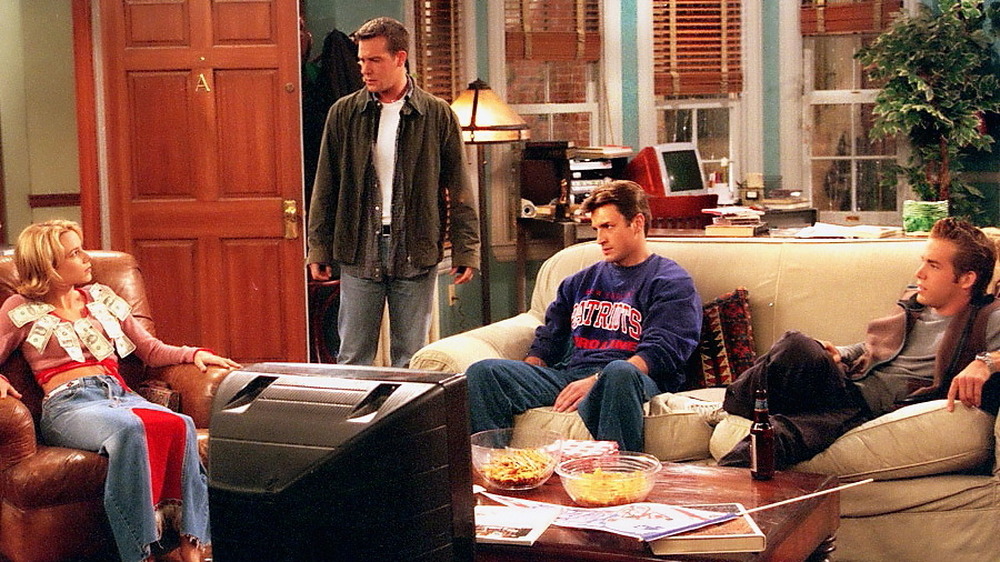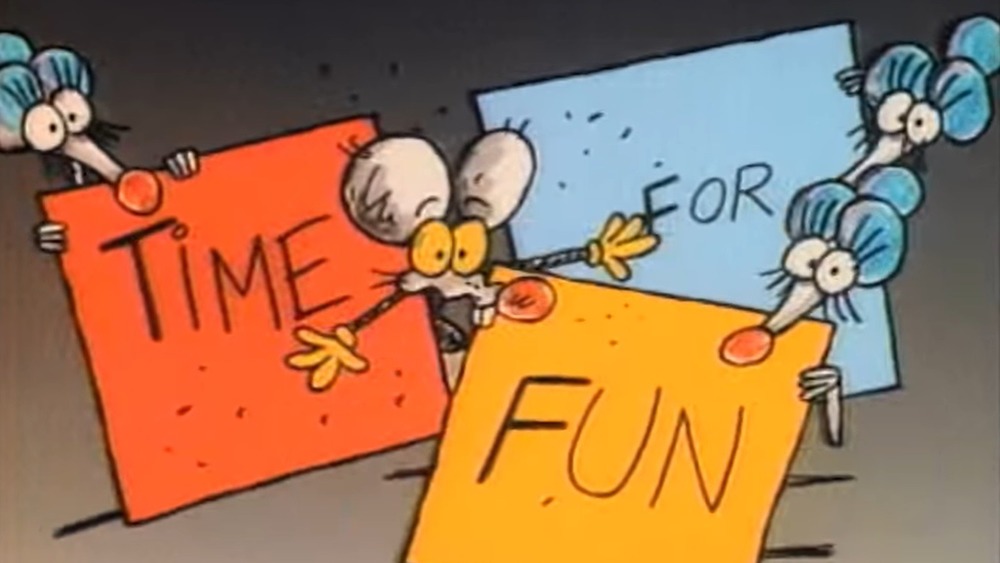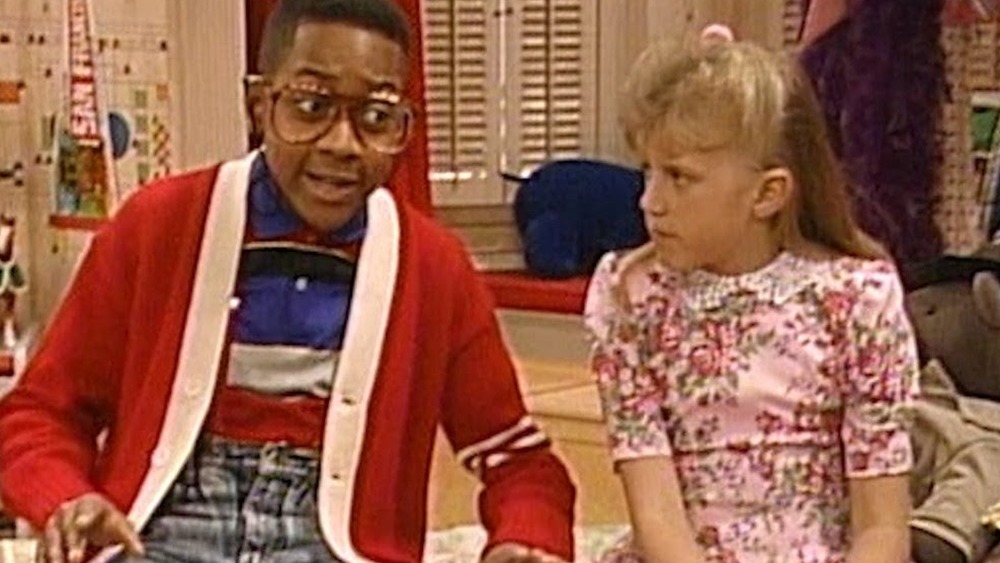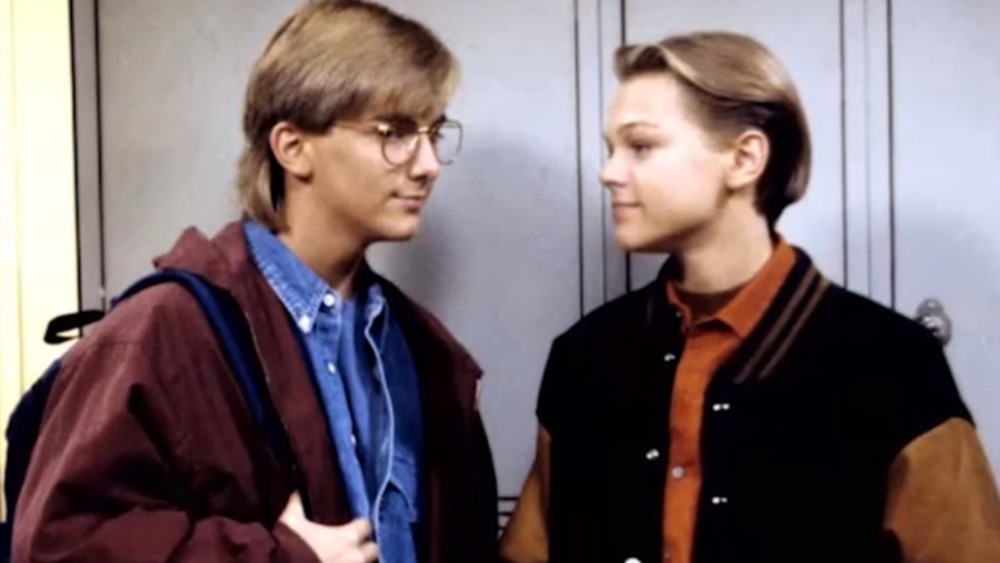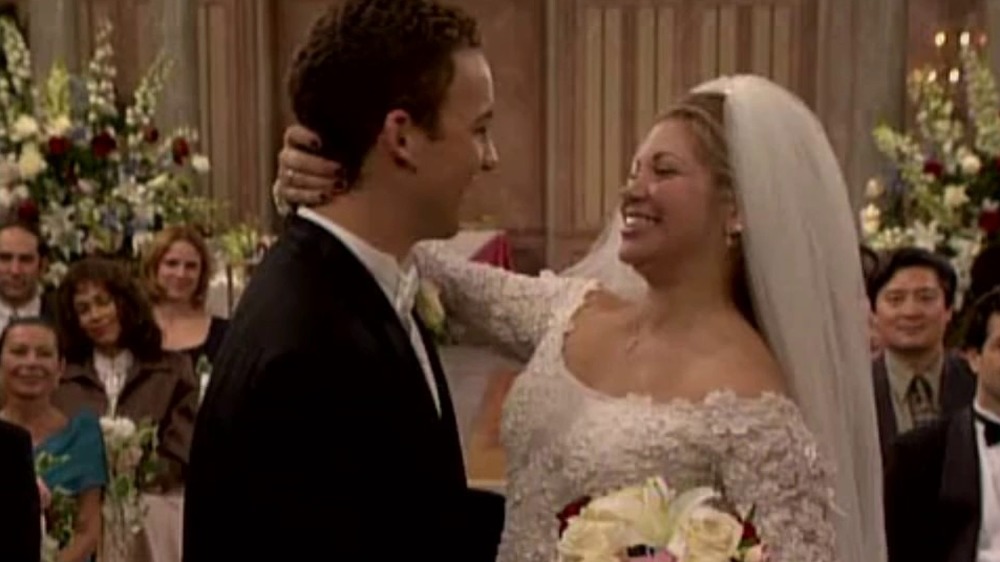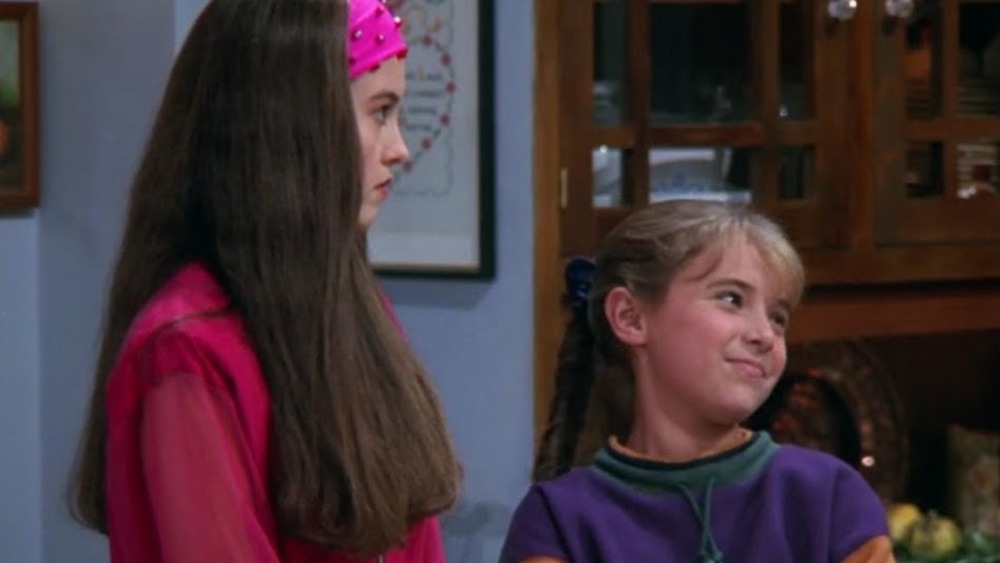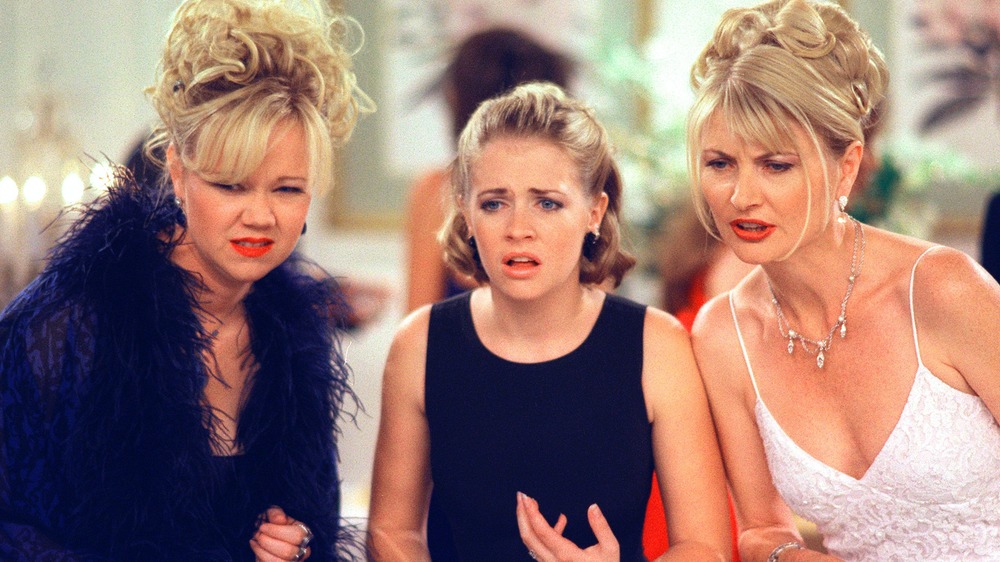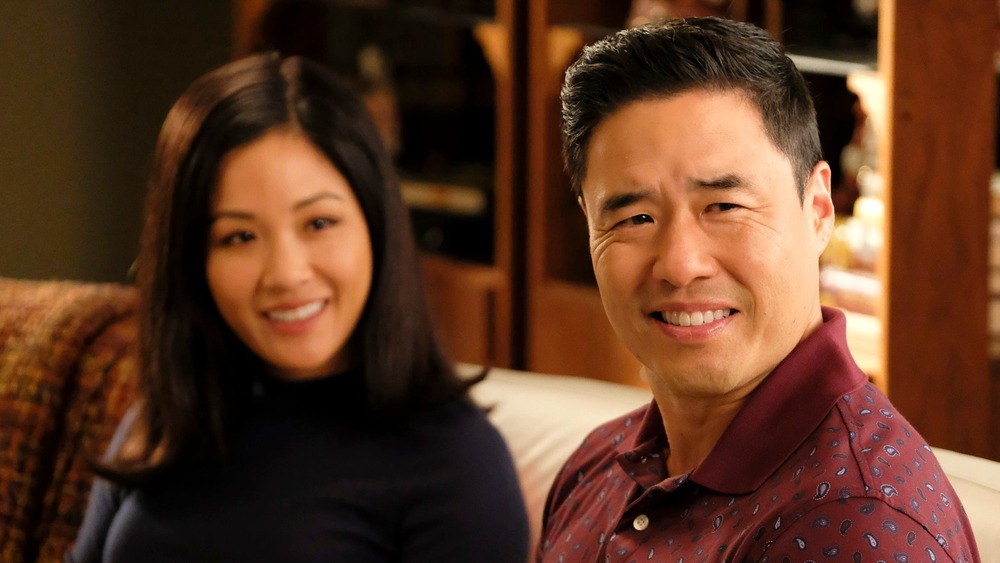The Untold Truth Of TGIF
For millions of kids, tweens, and their agreeable parents, TGIF was appointment viewing across the country in the 1990s. Not since Saturday morning cartoons had young people been given a large block of television just for them, which in this case was two hours on ABC's primetime schedule on Friday nights, loaded wall to wall with broad, silly, family-friendly sitcoms, often with an easily digested moral.
More than just a bunch of thematically similar comedies airing in a row, TGIF was a fully branded, entertainment extravaganza, each show connected by segments in the middle of and between programs, enthusiastically hosted by actors as their characters from TGIF entries. The whole thing was an extremely successful franchise for ABC, which made ratings hits and Millennial cultural touchstones out of TGIF stalwarts like Full House, Family Matters, Boy Meets World, Step by Step, Sabrina the Teenage Witch, Perfect Strangers, Dinosaurs, and Hangin' with Mr. Cooper. There was nothing quite like TGIF on the air before, then, or since. Here's the whole story.
TGIF before TGIF
Before the creation of TGIF in 1989, it wasn't like ABC was filling its Friday nights with gritty crime dramas (like CBS does today) or reality shows and newsmagazines (like ABC does today). The branding of TGIF on a Friday-based collection of kid-oriented, family-appropriate sitcoms just made official what the network had been doing on that night for decades. Friday nights on ABC had been the home over the years for The Flintstones, The Brady Bunch, The Partridge Family, and Webster.
Bob Iger became ABC Entertainment's president in early 1989, not long after programmers had moved established comedies Perfect Strangers and Full House to Fridays. Those shows appealed to people of all ages, and Iger thought that the one-hour block of innocuous sitcoms could be expanded and capture bigger audiences in the process. "A lot of families weren't watching TV together as much as when I was growing up," Iger told Entertainment Weekly. "But I thought, 'If we could program shows where parents and kids could watch together, we'd be better off.'" He supplemented Perfect Strangers and Full House with the Growing Pains spinoff Just the Ten of Us and the Perfect Strangers spinoff Family Matters.
Why TGIF was a success
Even though it was largely a television experiment without precedent, ABC executives had high hopes for TGIF. Why? Well, there are two reasons. Firstly, soothing, gentle comedies would serve as counter-programming to the adult-oriented soaps and dramas the other networks ran on Friday nights. And secondly, the block would address an underserved segment of the population. "As soon as they can get out of the house, teens leave on Friday nights," former ABC executive Ted Harbert told Entertainment Weekly. "You're left with parents and their kids."
So, all the network needed was what Full House producer Robert L. Boyett called "a promotional hook for multiple shows on Friday, a bridge to get from one show to the other and keep people watching." The job fell to promo writer Jim Janicek, inspired to frame TGIF and make it feel like TV franchises of the past. "Every Sunday, we as a family would sit down on the couch and watch Mutual of Omaha's Wild Kingdom and Disney Sunday Movie. I remember the feeling, and as a kid I was so fond of that, and I really wanted that again," Janicek said.
'Friday Night Laughtacular' doesn't have the same ring
Once given the assignment of collectively grouping its Friday night family-friendly comedies so as to more effectively advertise them as a whole, ABC promotional department writer Jim Janicek first had to come up a name for the block. And he and his team had a lot of ideas. "We had 10,000 different names," he told Entertainment Weekly. Among the rejected ones, there was "Friday Night Funnies, Fresh New Funnies, Friday Fun Club, Friday Laugh Factory, Friday Night Laughtacular, Time for Fun."
"TGIF" was a contender on that early list of possibilities, but Janicek found it potentially problematic. "There was an existing restaurant chain," he said, referring to TGI Fridays, "and there also was the existing phrase, 'Thank God it's Friday,' so part of me was concerned that we would not get through our title." Janicek fully believed ABC would thusly make him come up with a new one. ABC marketing VP Mark Zakarin gunned for TGIF, however, "because it's not just a silly name, it's actually an emotion," as well as already being a highly recognizable phrase. Finally, ABC president Bob Iger allowed the acronym to be used, with a tweak. As he explained, "I said, 'How about calling it 'Thank Goodness It's Funny'?' We didn't want to use God."
TGIF was a showcase for one TV production company
Early in the run of TGIF, ABC conducted audience research to determine just how much the programming block was resonating with viewers. TGIF executive producer Jim Janicek talked to Entertainment Weekly about a representative moment when viewers identified a picture of what he believed to be a Full House actor as "the guy from TGIF." Network executives were worried about differentiation, and that speaks to the striking similarity between TGIF shows. The vast majority of early and golden age TGIF programs all had a similar feel or flavor because they were made by the same company: Miller-Boyett Productions. Among its contributions to ABC's Friday night lineup, there was Full House, Family Matters, Step by Step, Going Places, and Perfect Strangers.
Even TGIF entries not produced by Thomas L. Miller and Robert L. Boyett used the duo's secret formula. "There were two basic elements that we felt were important: One was to give every show some moment of real human connection," Boyett told EW. "The second thing was, we tried to fulfill the fantasy where a dad would sit on the soda and say, 'What's the problem, son? Let's talk.'" Boyett says that element was the creation of Miller, and in TGIF circles, that warm and fuzzy moment came to be known as "Miller Time."
Not every TGIF show was a classic
As each TGIF-loaded Friday night progressed, the shows grew ever so slightly more mature. Agreeable, family fare like Full House, Family Matters, and Step by Step usually occupied the first hour and a half, while the fourth and final slot, beginning at 9:30 PM, was something of a wild card for ABC. In contrast to the consistent success of shows that ran early in the night, shows given the last TGIF spot struggled to find viewers. Among the series that came and went from the 9:30 slot in the '90s were low-rated, forgettable, quickly shuffled out duds like Camp Wilder, Where I Live, Teen Angel, You Wish, and Brother's Keeper.
However, as TGIF aged, so too did TGIF viewers. ABC accommodated their changing tastes with teen-oriented stuff like Boy Meets World, Sister, Sister, and Sabrina the Teenage Witch. What didn't work at all for TGIF and ABC was targeting adults. Several times, programmers tried to throw in a sitcom for an older audience, and it rarely worked. TGIF just wasn't the place for a show about TV writers (Going Places), another show about TV writers (Hiller and Diller), or a 20-something rom-com (Two Guys, a Girl and a Pizza Place).
TGIF had two theme songs
Music has traditionally been a big part of TV. Shows have their theme songs, and advertised products are made more familiar with catchy commercial jingles, but TGIF is one of the few times in television history that an amorphous programming block — or a large portion of a network's primetime schedule — received its own theme. TGIF actually had two introductory songs to get viewers pumped up for two full hours of Friday night fun, which not only set the tone and established the TGIF brand but also made it very clear to audiences that the acronym stood not for "Thank God It's Friday," but "Thank Goodness It's Funny."
The first attempt featured an animated intro that included some would-be mascots in a couple of cartoon mice, leading into the famous TGIF actor-led hosting segments. (According to the lyrics, TGIF is "time for fun, time for a good laugh, it's funny.") That version was quickly replaced with the more familiar, long-used theme song asserting that "it's Friday night, and the mood is right," along with a graphical animation featuring the letters "TGIF" and a classical comedy mask flying across the screen.
TGIF had a lot of crossovers
While TGIF shows were mostly made by the same people, and each ran seamlessly into the next thanks to hosting segments, the individual programs that made up the block were mostly self-contained and independent ... except for the occasional, widely hyped, all-encompassing crossover events that recurred through the history of TGIF. Every now and then, the producers of each show would conspire (or take direction from ABC brass) to write around a particular theme or concept, making for a two-hour television event. For example, to hype ABC's three-part Beatles Anthology documentary in 1995, all four TGIF shows featured Beatles songs and Beatles references. Well, not Boy Meets World, which went rogue and welcomed three of the Beatles-like Monkees as guest stars. And in 1997, all four TGIF comedies had wacky, sci-fi plots involving time travel.
Crossovers also served to make it official TGIF canon that its series shared the same fictional universe. In January 1991, Family Matters breakout character Steve Urkel (Jaleel White) found himself out of Chicago and stopping by the Tanners' San Francisco home on Full House, helping Stephanie (Jodie Sweetin) to accept the fact that she has to wear eyeglasses. Later that year, Urkel helped out another TGIF character, Step by Step's Mark Lambert (Christopher Castile). They're remote lab partners, and they meet in person when a jetpack-wearing Urkel crash-lands in the Lamberts' backyard. (Of course, he whines out his catchphrase — "Did I do that?" — to the cheers of the studio audience.)
ABC unsuccessfully ported TGIF to other nights
ABC dominated the broadcast TV ratings in the early 1990s and not just on Friday nights with its two-hour lineup of TGIF sitcoms. The network had top 20 comedy hits spread throughout the week, including Roseanne, Coach, Home Improvement, Who's the Boss?, Growing Pains, Head of the Class, and The Wonder Years. Executives figured if the TGIF branding worked so well to promote and bolster its Friday programming, a similar branded block approach could give other nights their own unique sensibility, too.
In 1991, ABC began to apply the TGIF principles, launching The Hump on Wednesday nights (referencing how the day is all about "getting over the hump" before cruising to the weekend). Like TGIF, The Hump got its own special theme song. Unlike TGIF, The Hump didn't have hosting segments. Plus, it disappeared after a few months. ABC tried again in 1992 with I Love Saturday Night, a TGIF clone where the network placed TGIF-appropriate but aging '80s-style sitcoms on their last legs, including Who's the Boss? and Growing Pains. It lasted just weeks, with the shows struggling to compete against NBC's top-rated lineup of adult-oriented comedies like The Golden Girls and Empty Nest.
ABC executives interfered with TGIF plots
Apart from the occasional "very special episode" about underage drinking or another social issue (for which consequences were swiftly and efficiently delivered), TGIF maintained a strict baseline of cleanliness and moral fortitude. After all, they were attracting millions of young viewers each week and assuring parents and big-spending advertisers that they'd get what was promised, so ABC was very hands-on with the content of TGIF programs.
For example, ABC Entertainment executive VP Ted Harbert objected to the Dinosaurs series finale, in which the entire prehistoric dinosaur population dies. He specifically didn't want the show's beloved character Baby Sinclair to die. "I said, 'Ted, they went extinct. I didn't do it. If you're going to cancel the show, I'm going to cancel the dinosaurs," Dinosaurs executive producer Michael Jacobs told Entertainment Weekly.
Herbert also grew incensed when Boy Meets World producers planned to marry the show's central couple, 19-year-olds Cory and Topanga. Jacobs suggested running a poll on ABC's website asking fans if they thought the pair should get hitched. The pro-marriage response was so overwhelming that Harbert ordered Boy Meets World writers to schedule the wedding episode in the highly watched "Sweeps" period.
CBS attempted its own TGIF
ABC's clean and careful packaging of clean and careful sitcoms was met with huge ratings, making TGIF the envy of the other broadcast networks. In 1997, CBS endeavored to make its own block of family-friendly comedies and place it on Friday nights, putting it in direct competition with ABC's TGIF. The other way the Eye Network proved to the Alphabet Network that it wasn't messing around in coming for its throne was poaching two of ABC's longest-running and most TGIF-associated shows. And so, CBS' generically titled Block Party hit the air in September 1997, bookended by Family Matters in the leadoff spot at 8 PM and Step by Step in the last segment at 9:30 PM. In between came new shows Meego, starring Perfect Strangers veteran Bronson Pinchot as a wacky alien, and The Gregory Hines Show.
CBS' gambit was a disaster. Meego was cancelled after six episodes, and The Gregory Hines Show barely lasted a full season. Family Matters and Step by Step were already running on fumes when CBS got them, beginning their ninth and seventh season, respectively, and they got canceled at the end of the 1997-98 TV season. The Block Party concept didn't return for a second year.
The end of TGIF
All things must come to an end, and the TGIF disappeared from ABC in the spring of 2000 after a remarkable, 11-year run. No single incident led to its demise. Instead, it was more of a combination of evolving tastes, the departure of important personnel, and new strategies from corporate overseers.
According to the Los Angeles Times, ratings for TGIF fell over the years due to the rise of homes with multiple TVs (meaning parents and kids didn't watch shows together as much anymore) and the popularity of kid-friendly cable channels like Nickelodeon and Cartoon Network. ABC also lost a big part of its TGIF lineup in 2000 when it allowed Sabrina the Teenage Witch to jump to The WB. Plus, it had less appropriate shows in the pipeline after Thomas L. Miller and Robert L. Boyett, responsible for shows like Full House and Family Matters, retired after the flop of TGIF entry Two of a Kind. ABC's corporate parent, Disney, also wanted to take chances with shows more provocative than the usual TGIF sitcoms. "'Edge' is now the favorite word in each development meeting," Dinosaurs and Boy Meets World producer Michael Jacobs said.
The TGIF revivals flopped
After ABC officially retired the TGIF branding in 2000 — and all of the programming expectations and promises that came with that moniker — the network struggled to connect with viewers on Friday night. It ran various sitcoms and light reality shows before deciding to revive TGIF for the fall of 2003, just three years after getting rid of the idea.
As far as squeaky clean sitcoms that adults could tolerate but kids could relate to, the offerings of TGIF 2.0 were a mixed bag. George Lopez and 8 Simple Rules resonated with tweens and teens, but the office comedy Less Than Perfect and the behind-the-scenes-of-a-TV-show Life with Bonnie didn't. The TGIF revival ended after two seasons of low ratings. The best performer in the block was the #60-ranked Kelly Ripa vehicle Hope and Faith.
In 2018, ABC tried to tap into any nostalgia felt by original-run TGIF viewers, now well into adulthood and with kids of their own, by reviving its legendary Friday night block once more. Pre-existing and little-watched shows Fresh Off the Boat and Speechless couldn't save TGIF, and the network retired the idea once more.
